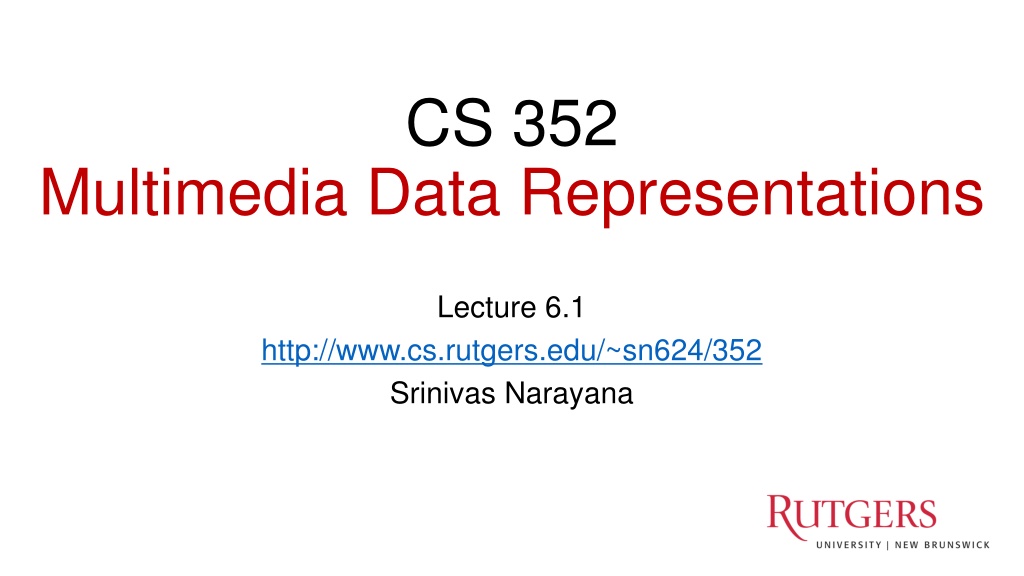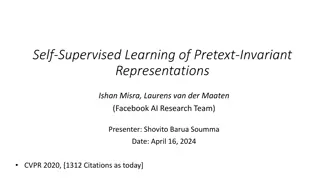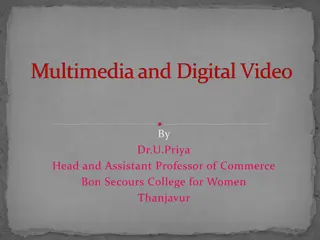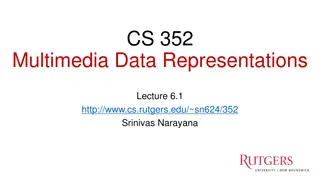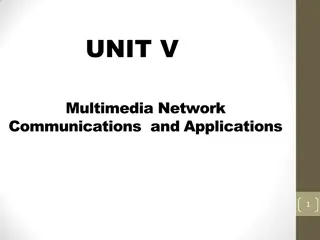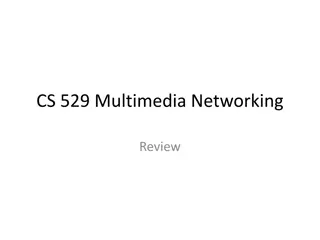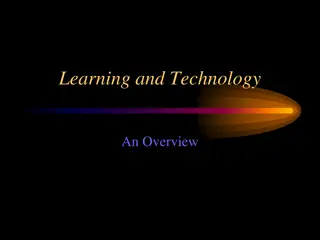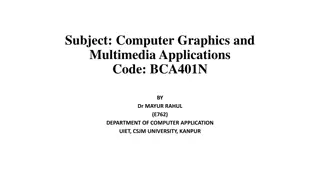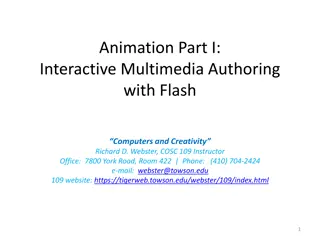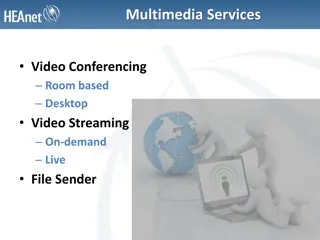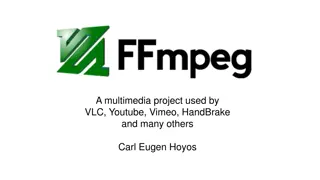Understanding Multimedia Data Representations in Networking
Multimedia applications on the internet rely heavily on audio and video data, with projections showing a significant increase in traffic by 2022. These applications differ from traditional ones in terms of real-time delivery requirements and sensitivity to delays. Digital representation of audio involves sampling, quantization, and compression techniques. Audio representation examples illustrate the bandwidth needed for transmitting audio signals effectively.
Download Presentation

Please find below an Image/Link to download the presentation.
The content on the website is provided AS IS for your information and personal use only. It may not be sold, licensed, or shared on other websites without obtaining consent from the author. Download presentation by click this link. If you encounter any issues during the download, it is possible that the publisher has removed the file from their server.
E N D
Presentation Transcript
CS 352 Multimedia Data Representations Lecture 6.1 http://www.cs.rutgers.edu/~sn624/352 Srinivas Narayana 1
Multimedia networking Many applications on the Internet use audio or video IP video traffic will be 82 percent of all IP traffic [ ] by 2022, up from 75 percent in 2017 CCTV traffic over the Internet will increase sevenfold between 2017 to 2022 Internet video to TV will increase threefold between 2017 to 2022. Consumer Video-on-Demand (VoD) traffic will nearly double by 2022 Source: Cisco visual networking index 2017--22 2
Whats different about these applications? Traditional applications (HTTP(S), SMTP) Delay tolerant but not loss tolerant Data used after transfer complete Multimedia applications are often real time Data delivery time during transfer matters for user experience Video/audio streaming Delay-sensitive Real-time audio and video Delays > 400 ms for audio is a bad user experience Somewhat loss tolerant 3
Digital representation of audio and video
Digital representation of audio Must convert analog signal to digital representation Sample How many times (twice the max frequency in the signal) Quantize How many levels or bits to represent each sample More levels more accuracy More levels more bits to store & more bandwidth to transmit Compress Compact representation of quantized values 5
Audio representation analog audio signal sampled at constant rate telephone: 8,000 samples/sec CD music: 44,100 samples/sec each sample quantized, i.e., rounded e.g., 28=256 possible quantized values each quantized value represented by bits, e.g., 8 bits for 256 values quantization quantized value of analog value error audio signal amplitude analog signal time sampling rate (N sample/sec) 6
Audio representation example: 8,000 samples/sec, 256 quantized values Bandwidth needed: 64,000 bps quantization quantized value of analog value error audio signal amplitude analog signal receiver converts bits back to analog signal: some quality reduction time Example rates CD: 1.411 Mbps MP3: 96, 128, 160 Kbps Internet telephony: 5.3 Kbps and up sampling rate (N sample/sec) 7
Video representation Video: sequence of images displayed at constant rate e.g., 30 images/sec Appear continuous due to persistence of vision /stroboscopic effect. frame i frame i+1 8
Video representation spatial coding example: instead of sending N values of same color (all purple), send only two values: color value (purple) and number of repeated values (N) Digital image: array of pixels each pixel represented by bits Coding: use redundancy within and between images to decrease # bits used to encode image spatial (within image) temporal (from one image to next) Coding/decoding algorithm often called a codec ... ... frame i temporal coding example: instead of sending complete frame at i+1, send only differences from frame i frame i+1 9
Video representation Video bit rate: effective number of bits per second of the video after encoding Depends on quality of each image. More pixels, more detail per pixel = more bits Depends on effectiveness of compression in the codec Video bit rate is typically correlated with quality. CBR: (constant bit rate): fixed bit-rate video VBR: (variable bit rate): different parts of the video have different bit rates, e.g., changes in color, motion, etc. Examples of average video bit-rates: MPEG 1 (CD-ROM) 1.5 Mbps. MPEG2 (DVD) 3-6 Mbps MPEG4 (often used in Internet, < 1 Mbps) In general, one Internet video stream takes up a few Mbit/s (that s it.) 10
Multimedia networking: 3 application types streaming, stored audio, video streaming: can begin playout before downloading entire file stored (at server): can transmit faster than audio/video will be rendered (implies storing/buffering at client) e.g., Spotify, YouTube, Netflix conversational voice/video over IP interactive nature of human-to-human conversation limits delay tolerance e.g., Zoom streaming live audio, video e.g., live sporting event (e.g., superbowl) 11
CS 352 Video Streaming Lecture 6.2 http://www.cs.rutgers.edu/~sn624/352 Srinivas Narayana 13
Streaming stored video Media is prerecorded at different qualities Client downloads an initial portion and starts viewing Rest downloaded as time progresses No need to wait for entire content to be downloaded Can change content sites mid-stream based on network conditions
Streaming stored video 2. video sent 1. video recorded (e.g., 30 frames/sec) 3. video received, played out at client (30 frames/sec) network delay (fixed in this example) time streaming: at this time, client playing out early part of video, while server still sending later part of video 15
Streaming stored video: challenges continuous playout constraint: once client playout begins, playback must match original timing but network delays are variable (jitter), so will need client-side buffer to match playout requirements other challenges: client interactivity: pause, fast-forward, rewind, jump through video video packets may be lost, retransmitted 16
Scenario 1: Constant bit-rate video constant bit rate video transmission client video reception constant bit rate video playout at client variable network delay buffered video time client playout delay client-side buffering and playout delay: compensate for network-added delay, delay jitter 17
Client-side buffering, playout buffer fill level, B(t) playout rate, e.g., CBR r variable fill rate, x(t) client application buffer, size Bmax video server client Video is downloaded chunk by chunk (typically using the HTTP protocol) For example: a chunk might be 4 seconds worth of video. 18
Client-side buffering, playout buffer fill level, B(t) playout rate, e.g., CBR r variable fill rate, x(t) client application buffer, size Bmax video server client 1. Initial fill of buffer until playout begins at tp 2. playout begins at tp, 3. buffer fill level varies over time as fill rate x(t) varies and playout rate r is constant 19
Client-side buffering, playout buffer fill level, Q(t) playout rate, e.g., CBR r variable fill rate, x(t) client application buffer, size B video server playout buffering: average fill rate (x), playout rate (r): x < r: buffer eventually empties (causing freezing of video playout until next chunk downloaded). Rebuffering event x > r: buffer will not empty, provided initial playout delay is large enough to absorb variability in x(t) initial playout delay tradeoff: buffer starvation less likely with larger delay, but larger delay until user begins watching 20
Client-side buffering, playout buffer fill level, Q(t) playout rate, e.g., CBR r variable fill rate, x(t) client application buffer, size B video server playout buffering: average fill rate (x), playout rate (r): is x < r or x > r for a given network connection? It is hard to predict this in general. How to set r? Too low a bit-rate r: video has poorer quality than needed Too high a bit-rate r: buffer might empty out. Rebuffering! 21
Scenario 2: Adaptive bitrate video Motivation: Want to provide high quality video experience, without rebuffering Adapt bit rate collaboratively between the video client (e.g., YouTube player on your browser) and the server Adaptive bit-rate (ABR) video: change the bit-rate (quality) of next chunk, based on network and client conditions. A typical strategy: Buffer-based rate adaptation
Buffer-based Rate Adaptation Key idea: If there is a large stored buffer of video, optimize aggressively for video quality, i.e., high bit rates Conversely, if there is a small stored buffer of video, be conservative and ask for a lower quality The hope is that the lower bandwidth requirement can be satisfied by the connection more easily.
Buffer-based bit-rate adaptation A highly effective method to provide high video quality despite variable and intermittently poor network conditions. Used by Netflix. http://yuba.stanford.edu/~nickm/papers/sigcomm2014-video.pdf A Buffer-Based Approach to Rate Adaptation
